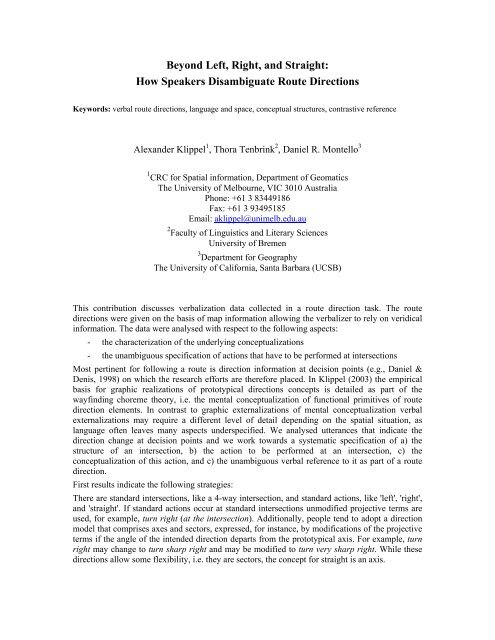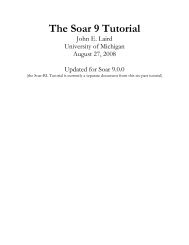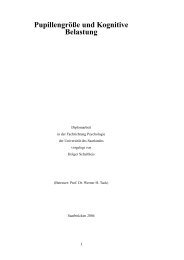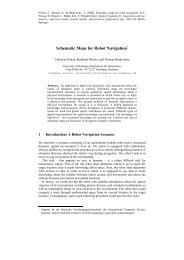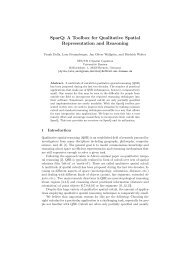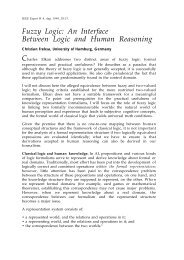Beyond Left, Right, and Straight - the Cognitive Systems Group
Beyond Left, Right, and Straight - the Cognitive Systems Group
Beyond Left, Right, and Straight - the Cognitive Systems Group
Create successful ePaper yourself
Turn your PDF publications into a flip-book with our unique Google optimized e-Paper software.
<strong>Beyond</strong> <strong>Left</strong>, <strong>Right</strong>, <strong>and</strong> <strong>Straight</strong>:<br />
How Speakers Disambiguate Route Directions<br />
Keywords: verbal route directions, language <strong>and</strong> space, conceptual structures, contrastive reference<br />
Alex<strong>and</strong>er Klippel 1 , Thora Tenbrink 2 , Daniel R. Montello 3<br />
1 CRC for Spatial information, Department of Geomatics<br />
The University of Melbourne, VIC 3010 Australia<br />
Phone: +61 3 83449186<br />
Fax: +61 3 93495185<br />
Email: aklippel@unimelb.edu.au<br />
2 Faculty of Linguistics <strong>and</strong> Literary Sciences<br />
University of Bremen<br />
3 Department for Geography<br />
The University of California, Santa Barbara (UCSB)<br />
This contribution discusses verbalization data collected in a route direction task. The route<br />
directions were given on <strong>the</strong> basis of map information allowing <strong>the</strong> verbalizer to rely on veridical<br />
information. The data were analysed with respect to <strong>the</strong> following aspects:<br />
- <strong>the</strong> characterization of <strong>the</strong> underlying conceptualizations<br />
- <strong>the</strong> unambiguous specification of actions that have to be performed at intersections<br />
Most pertinent for following a route is direction information at decision points (e.g., Daniel &<br />
Denis, 1998) on which <strong>the</strong> research efforts are <strong>the</strong>refore placed. In Klippel (2003) <strong>the</strong> empirical<br />
basis for graphic realizations of prototypical directions concepts is detailed as part of <strong>the</strong><br />
wayfinding choreme <strong>the</strong>ory, i.e. <strong>the</strong> mental conceptualization of functional primitives of route<br />
direction elements. In contrast to graphic externalizations of mental conceptualization verbal<br />
externalizations may require a different level of detail depending on <strong>the</strong> spatial situation, as<br />
language often leaves many aspects underspecified. We analysed utterances that indicate <strong>the</strong><br />
direction change at decision points <strong>and</strong> we work towards a systematic specification of a) <strong>the</strong><br />
structure of an intersection, b) <strong>the</strong> action to be performed at an intersection, c) <strong>the</strong><br />
conceptualization of this action, <strong>and</strong> c) <strong>the</strong> unambiguous verbal reference to it as part of a route<br />
direction.<br />
First results indicate <strong>the</strong> following strategies:<br />
There are st<strong>and</strong>ard intersections, like a 4-way intersection, <strong>and</strong> st<strong>and</strong>ard actions, like 'left', 'right',<br />
<strong>and</strong> 'straight'. If st<strong>and</strong>ard actions occur at st<strong>and</strong>ard intersections unmodified projective terms are<br />
used, for example, turn right (at <strong>the</strong> intersection). Additionally, people tend to adopt a direction<br />
model that comprises axes <strong>and</strong> sectors, expressed, for instance, by modifications of <strong>the</strong> projective<br />
terms if <strong>the</strong> angle of <strong>the</strong> intended direction departs from <strong>the</strong> prototypical axis. For example, turn<br />
right may change to turn sharp right <strong>and</strong> may be modified to turn very sharp right. While <strong>the</strong>se<br />
directions allow some flexibility, i.e. <strong>the</strong>y are sectors, <strong>the</strong> concept for straight is an axis.
The strategies participants adopt change if <strong>the</strong> action to be instructed takes place a) at a complex<br />
intersection or b) if competing branches require a disambiguation of <strong>the</strong> situation. For <strong>the</strong><br />
identification of object locations Tenbrink (2005) provides results on how <strong>the</strong> contrast of<br />
competing objects can be enhanced. Some ideas on how contrastive reference can be achieved in<br />
route directions were presented by Klippel <strong>and</strong> Montello (2004). Besides rendering <strong>the</strong> direction<br />
concept precise, for example, by providing detailed descriptions according to <strong>the</strong> direction model,<br />
<strong>and</strong> possibly relying on clock directions or an absolute reference system, participants adopt <strong>the</strong><br />
following strategies: naming <strong>the</strong> structure in which <strong>the</strong> actions take place plus a coarse direction<br />
concept (e.g., fork right), a comparison of possibilities to take (e.g., fur<strong>the</strong>st right), a conceptual<br />
change to ordering information plus a coarse direction concept (e.g., <strong>the</strong> third to your left), <strong>the</strong><br />
description of competing directions not to take, or any combination of <strong>the</strong>se strategies. The<br />
situation changes again if l<strong>and</strong>marks are present.<br />
We analysed two corpora <strong>and</strong> will present a quantitative analysis of <strong>the</strong> strategies used. This<br />
research adds to <strong>the</strong> pending question criteria for good route directions (Dale, Geldof, & Prost,<br />
2005).<br />
References<br />
Dale, R., Geldof, S., & Prost, J.-P. (2005). Using natural language generation in automatic route description. Journal of<br />
Research <strong>and</strong> practice in Information Technology, 37(1), 89-105.<br />
Daniel, M. P., & Denis, M. (1998). Spatial descriptions as navigational aids: A cognitive analysis of route directions.<br />
Kognitionswissenschaft, 7(1), 45-52.<br />
Klippel, A. (2003). Wayfinding Choremes. In W. Kuhn, M. Worboys & S. Timpf (Eds.), Spatial Information Theory:<br />
Foundations of Geographic Information Science. Conference on Spatial Information Theory (COSIT) 2003.<br />
(pp. 320-334). Berlin: Springer.<br />
Klippel, A., & Montello, D. R. (2004). On <strong>the</strong> robustness of mental conceptualizations of turn direction concepts. In M.<br />
J. Egenhofer, C. Freksa & H. Miller (Eds.), GIScience 2004. The Thrid International Conference on<br />
Geogrpahic Information Science, October 20-23, 2004, University of Maryl<strong>and</strong> (Extended Abstract). (pp.<br />
139-141). Adelphi, Maryl<strong>and</strong>, U.S.A.: Regents of <strong>the</strong> University of California.<br />
Tenbrink, T. (2005). Identifying objects on <strong>the</strong> basis of spatial contrast: An empirical study. In C. Freksa, M. Knauff &<br />
B. Krieg-Brueckner (Eds.), Spatial Cognition IV. Reasoning, Action, <strong>and</strong> Interaction: International<br />
Conference Spatial Cognition 2004, Frauenchiemsee, Germany, October 11-13, 2004, Revised Selected<br />
Papers (Vol. Lecture Notes in Computer Science, Volume 3343, pp. 124-146). Berlin: Springer.


